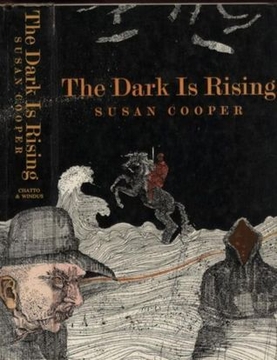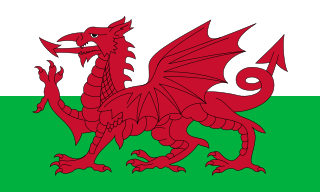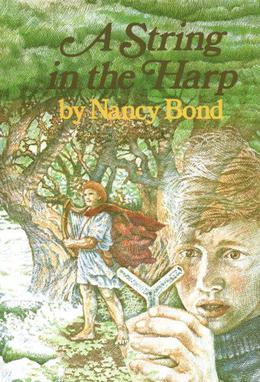
Susan Mary Cooper is an English author of children's books. She is best known for The Dark Is Rising, a contemporary fantasy series set in England and Wales, which incorporates British mythology such as the Arthurian legends and Welsh folk heroes. For that work, in 2012 she won the lifetime Margaret A. Edwards Award from the American Library Association, recognizing her contribution to writing for teens. In the 1970s two of the five novels were named the year's best English-language book with an "authentic Welsh background" by the Welsh Books Council. In 2024, the Science Fiction and Fantasy Writers Association named her the 40th Damon Knight Memorial Grand Master in recognition of her significant contributions to the literature of science fiction and fantasy.
Annwn, Annwfn, or Annwfyn is the Otherworld in Welsh mythology. Ruled by Arawn, it was essentially a world of delights and eternal youth where disease was absent and food was ever-abundant.
Cad Goddeu is a medieval Welsh poem preserved in the 14th-century manuscript known as the Book of Taliesin. The poem refers to a traditional story in which the legendary enchanter Gwydion animates the trees of the forest to fight as his army. The poem is especially notable for its striking and enigmatic symbolism and the wide variety of interpretations this has occasioned.

Culhwch and Olwen is a Welsh tale that survives in only two manuscripts about a hero connected with Arthur and his warriors: a complete version in the Red Book of Hergest, c. 1400, and a fragmented version in the White Book of Rhydderch, c. 1325. It is the longest of the surviving Welsh prose tales. Lady Charlotte Guest included this tale among those she collected under the title The Mabinogion.

The Dark Is Rising Sequence is a series of five contemporary fantasy novels for older children and young adults that were written by the British author Susan Cooper and published from 1965 to 1977. The first book in the series, Over Sea, Under Stone, was originally conceived as a stand-alone novel, and the sequence gets its name from the second novel in the series, The Dark Is Rising. The Dark Is Rising Sequence is used as an overarching title in several omnibus, boxed-set, and coordinated editions; but the title of The Dark Is Rising is also used for the whole series.

The Dark Is Rising is a 1973 children's fantasy novel by Susan Cooper. The second in The Dark Is Rising Sequence, the book won a Newbery Honor. It has been described as a "folkloric tale of an English boy caught in a battle between light and dark".

Welsh mythology consists of both folk traditions developed in Wales, and traditions developed by the Celtic Britons elsewhere before the end of the first millennium. As in most of the predominantly oral societies Celtic mythology and history were recorded orally by specialists such as druids. This oral record has been lost or altered as a result of outside contact and invasion over the years. Much of this altered mythology and history is preserved in medieval Welsh manuscripts, which include the Red Book of Hergest, the White Book of Rhydderch, the Book of Aneirin and the Book of Taliesin. Other works connected to Welsh mythology include the ninth-century Latin historical compilation Historia Brittonum and Geoffrey of Monmouth's twelfth-century Latin chronicle Historia Regum Britanniae, as well as later folklore, such as the materials collected in The Welsh Fairy Book by William Jenkyn Thomas (1908).

Silver on the Tree is a contemporary fantasy novel by Susan Cooper, published by Chatto & Windus in 1977. It is the final entry in the five book Dark Is Rising Sequence.

Over Sea, Under Stone is a contemporary fantasy novel written for children by the English author Susan Cooper, first published in London by Jonathan Cape in 1965. Cooper wrote four sequels about ten years later, making it the first volume in a series usually called The Dark Is Rising Sequence. In contrast to the rest of the series, it is more a mystery, with traditional fantasy elements mainly the subject of hints later in the narrative. Thus it may ease readers into the fantasy genre.
In Scottish folklore, Am Fear Liath Mòr is the name for a presence or creature which is said to haunt the summit and passes of Ben Macdui, the highest peak of the Cairngorms and the second highest peak in British Isles after Ben Nevis.

Cadair Idris or Cader Idris is a mountain in the Meirionnydd area of Gwynedd, Wales. It lies at the southern end of the Snowdonia National Park near the town of Dolgellau. The peak, which is one of the most popular in Wales for walkers and hikers, is composed largely of Ordovician igneous rocks, with classic glacial erosion features such as cwms, moraines, striated rocks, and roches moutonnées.
Caradog, Caradoc, Caradawg, or Cradawg, Latinised as Caratacus and anglicised as Craddock, is a given name for men in the Welsh language. It may refer to:
Nancy Barbara Bond is an American author of children's literature. In 1977 her first book, A String in the Harp, was fantasy novel with an element of folklore, set in West Wales. It received a Newbery honor and the Welsh Tir na n-Og Award, and remains in print.

Tal-y-llyn Lake,, also known as Talyllyn Lake and Llyn Myngul, is a large glacial ribbon lake in Gwynedd, North Wales. It is formed by a post-glacial massive landslip damming up the lake within the glaciated valley. The hamlet of Talyllyn lies at the west end of the lake.
The Tir na n-Og Awards are a set of annual children's literary awards in Wales from 1976. They are presented by the Books Council of Wales to the best books published during the preceding calendar year in each of three awards categories, one English-language and two Welsh-language. Their purpose is "[to raise] the standard of children's and young people's books and to encourage the buying and reading of good books." There is no restriction to fiction or prose. Each prize is £1,000.

Phyllis Ann Karr is an American author of fantasy, romances, mysteries, and non-fiction. She is best known for her "Frostflower and Thorn" series and Arthurian works.

Caradoc Vreichvras was a semi-legendary ancestor to the kings of Gwent. He may have lived during the 5th or 6th century. He is remembered in the Matter of Britain as a Knight of the Round Table, under the names King Carados and Carados Briefbras.
Cavall was King Arthur's dog, used in the hunt for the great boar, Twrch Trwyth.

A String in the Harp is a children's fantasy novel by Nancy Bond first published in 1976. It received a 1977 Newbery Honor award and the Welsh Tir na n-Og Award. It tells of the American Morgan family who temporarily move to Wales, where Peter Morgan finds a magical harp key that gives him vivid visions of the past. This well-received novel is an unusual time travel story, with its focus on the emotional pain and separation the Morgans experience after the death of their mother and the gradual healing they find through their experiences.
Brenin Llwyd, is a legendary figure in Welsh mythology. Recorded in mountainous locations throughout the country, the figure is always silent, semi-corporeal, is cloaked in mist or a grey cloak and preys on unwary travellers, especially children.












